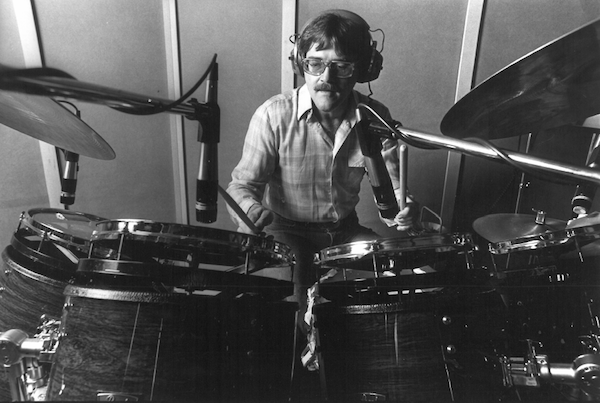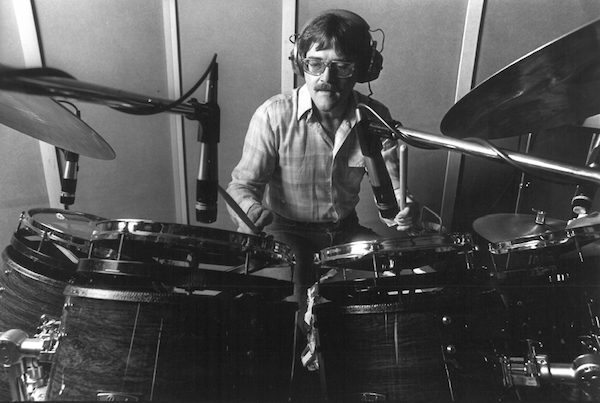Roger Hawkins 1945 – 2021

Modern Drummer is very sad to hear about the passing of legendary Muscle Shoals drummer Roger Hawkins. Roger bravely battled with health issues over the past few years, and our condolences go out to his wife Brenda, their family, friends, and admirers of his music. Roger is one of the most successful studio musicians of our time, and the songs he’s played will be heard forever. Here’s the last piece we did with Roger. Rest In Peace, Sir.
Look for more on Roger in an upcoming issue of Modern Drummer Magazine.
Reasons to Love: Roger Hawkins
by Jeff Potter

Speaking matter-of-factly but with a hint of reflective wonderment, Roger Hawkins chuckles, “We just kind of made it up as we went along.” Specifically, the ace session drummer is recalling how, as a member of the famed Muscle Shoals Rhythm Section, he and his bandmates created consummate instrumental parts and laid down tracks with a spontaneity and exhilarating groove that repeatedly made music history.
Hawkins is simply one of the greatest studio drummers of all time. His spot-on time, deep Southern-infused pocket, and uncluttered parts have fueled a long list of landmark soul and R&B classics with artists including Aretha Franklin, Etta James, and Wilson Pickett. His massive album discography features legends of rock, blues, country, and pop, including Bob Seger, Eric Clapton, Joe Cocker, Glenn Frey, Paul Simon, Duane Allman, Boz Scaggs, Rod Stewart, Lightnin’ Hopkins, Albert King, Bobby “Blue” Bland, Willie Nelson, the Oak Ridge Boys, Alabama, and many, many more. Advertisement
Hawkins began cutting soulful tracks in the mid-’60s as the house drummer at FAME Studios in Muscle Shoals, Alabama. Along with his core Muscle Shoals Rhythm Section bandmates—bassist David Hood, guitarist Jimmy Johnson, and keyboardist Barry Beckett—the unit (also known as “the Swampers” for their funky Southern feel) eventually became so in demand that they founded their own studio, Muscle Shoals Sound, in 1969. There they held court while top artists flocked southward to tap their sound through the following decades.
Asked to pinpoint the key to his drumming success, Hawkins says, “I don’tplay the drums. Thump your fist on your heart—that’s where the drums are from.” Here, Hawkins recalls four career-changing soul landmarks.
“When a Man Loves a Woman,” Percy Sledge
This ultra-classic track from February 1966 opened doors for Hawkins and his Muscle Shoals comrades. The drummer’s soulful, socked-in backbeat and urgent ride fuel the raw in-the-room energy on the scorching soul ballad. Advertisement
Atlantic Records picked it up for distribution, yielding the first number-one hit for the Muscle Shoals musicians. “[Legendary Atlantic producer] Jerry Wexler was impressed with that,” Hawkins says. “He called down and said, ‘Who are those guys playing on that record?’ That’s how he and [FAME owner/producer] Rick Hall joined up.”
“Land of 1000 Dances,” Wilson Pickett
Known for his sweaty, sexy, hard-groove funk, Wilson Pickett tracked numerous sides driven by Hawkins that remain cornerstones of soul, including “Mustang Sally,” “Funky Broadway,” and the July 1966 hit that turbo-charged the drummer’s career, “Land of 1000 Dances.” The fevered dance-party raver is trademarked by its irresistible drum/vocal breakdown.
“I interpreted a lot for him,” Hawkins says of Pickett. “If I started doing something he liked, he’d say, ‘Yeah! Hold that right there!’ Or sometimes he’d say, ‘Man, this stinks. I wish you guys could think of something else.’ Advertisement
“When we were recording this one, he said, ‘We need a breakdown right here while I’m singing ‘naaa, na-na-na-naaa….’ I was in the control room and I thought, He wants a breakdown? What am I gonna do? In my mind I knew something I might try. But he said, ‘Try this,’ and he was beating on his leg with his foot playing a pattern. He said, ‘Can you do that?’ And the breakdown was cookin’; it was great!
“As the years went by, I always wanted to tell him, ‘Thank you for giving me that part—it helped my career so much.’ I always told everybody, ‘It wasn’t me, it was Wilson Pickett!’”
“Think” and the Aretha Atlantic Sessions
When Atlantic Records signed Aretha Franklin, she had previously recorded for Columbia with only moderate results; the label hadn’t yet tapped her full potential. Seeking to reconnect Aretha with her gospel roots, Wexler made the unorthodox decision to send her to Muscle Shoals to record with the white Southern rhythm section that had so impressed him. The results were a turning point, setting the stage for the singer to blossom into the Queen of Soul.
The first session, slated at FAME Studios on January 24, 1967, yielded the sublime classic “I Never Loved a Man (the Way I Love You).” “When we started cutting tracks with Aretha, she was very pleased,” Hawkins recalls. “And I somewhat vibed with her, because we’d kind of look at each other every now and again. She would look over at me and smile. To me that meant I was playing a part that she liked. We didn’t get any closer than that, but there was a real communication in the studio.” Advertisement
Wexler invited the musicians to New York for follow-up sessions, and the hits kept rolling. Over subsequent years, Hawkins drove multiple Franklin smashes, including “Chain of Fools,” “Save Me,” “Drown in My Own Tears,” “Baby I Love You,” “The House That Jack Built,” “I Say a Little Prayer,” the game-changing “Respect,” and the titanic “Think.” On April 15, 1968, during the recording of that last watershed track, with its stratospheric “Freedom!” refrain, Hawkins connected with Aretha’s church roots.
“The first time I ever played drums was in the church,” Hawkins says. “I was about eleven years old. And when I’d go to a Pentecostal church in Indiana with my aunt, they’d play what they called the ‘sanctified beat,’ where the drums played a four-on-the-floor. So when Aretha was singing, ‘You’d better think, think…’ I thought, I’ve heard this kind of piano playing before. It’s a sanctified beat, and that’s the only thing I knew how to play on that. Then Jerry Wexler said, ‘Hey, Roger, try something a bit more syncopated,’ because he was used to the bass drum doing a lot of syncopation. Aretha looked at me, smiled, and said, ‘Jerry, Roger’s playing the right thing.’ [laughs] That’s how I got to stick to that part, because she had felt it.”
“I’ll Take You There,” the Staple Singers
The Swampers backed the Stax artists the Staple Singers with spectacular results, including the classic track “Respect Yourself” and the number that topped both the soul and pop charts in February 1972, “I’ll Take You There.” Hawkins’ hybrid soul/reggae-inflected drum part helped make the tune one of the deepest tracks in groove history. Advertisement
“That was kind of an outrageous part back then,” Hawkins says. “Not braggin’ about it, but it’s one of my favorite tracks that I ever had the pleasure of playing on. We had gone on tour with Traffic, and during that time reggae and ska were being introduced to England, so we heard a lot of that and were influenced by it.
“I probably got the cross-stick idea from the Jamaican players; that was going through my head. So I tried to play a reggae type of bass drum part on 2 and 4 instead of on 1 and 3. But after a couple times hearing it back, I just knew that wasn’t working. No one said that. But when I listened, I said, Man, that’s dragging it down with the other things going on. So I thought, Well, America likes 2 and 4, so I changed the bass drum to the more traditional thing. I turned the foot around, and that worked real good. Then everybody started moving.
“There were two Neumann mics over the drums and a mic on the bass drum—the only mics there. I started thinking about those little surprise timbale hits in reggae. So I lowered the overhead mic down pretty close to the head of the snare drum. I told the engineer what I was doing so he wouldn’t get spiked out. I played, then listened back and thought, This is not quite it. So I pulled that mic down even more, and the close miking allowed me to get it all at once: the snare drum part with the cross-stick and the timbale-like hits. Advertisement
“Once I listened back, I thought, There’s nothing like this! There are points when you’re playing on that kind of track, and all of a sudden it’s, Good God! This is great! How am I doing this? And you just try to use your mind to stick with it.” Hawkins adds with a laugh, “Because when you try to analyze—How am I doing this?—you’re setting yourself up for failure.”


